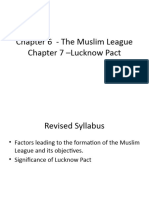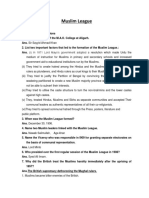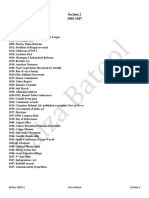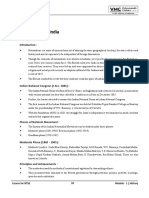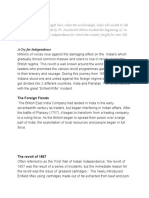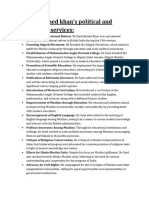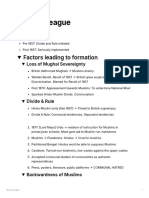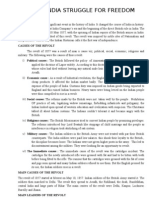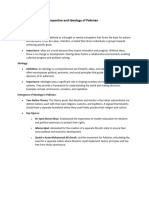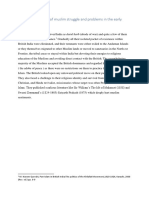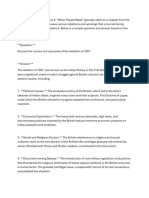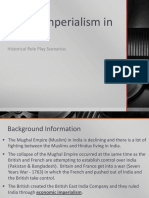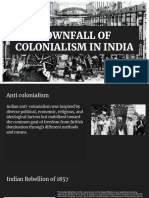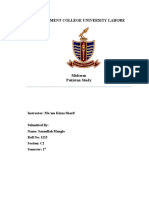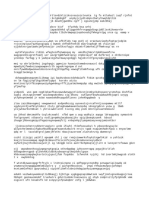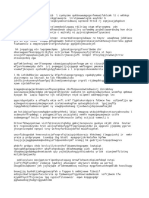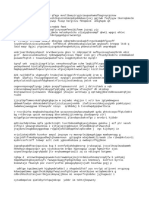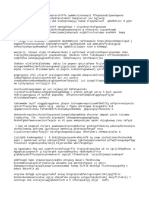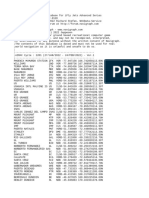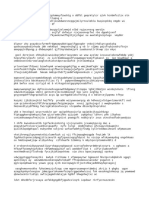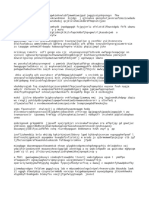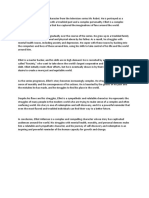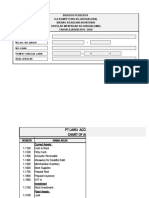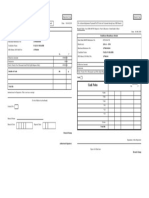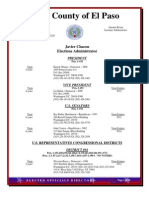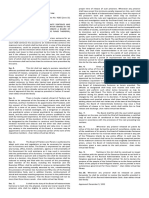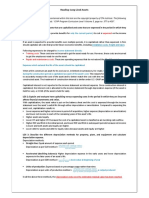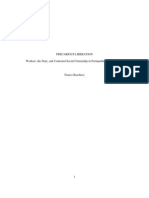0 ratings0% found this document useful (0 votes)
98 viewsThe Factors Leading To The Formation of The Muslim League
The Factors Leading To The Formation of The Muslim League
Uploaded by
chaituThe factors leading to the formation of the Muslim League were:
1) The loss of sovereignty of the Mughal rulers and British domination made Muslims bitter enemies of the British and view them with suspicion.
2) The British policy of "Divide and Rule" which included favoring Muslims in schools, spreading communal hatred, and justifying the partition of Bengal to create a Muslim majority region.
3) The economic backwardness of India due to British policies led to fewer jobs and more competition among Indians based on religion, which the British exploited to increase communal tensions between Hindus and Muslims.
4) Some early nationalists' actions, like certain festivals and the idea that nationalism was a religion, annoyed some Indians and took
Copyright:
© All Rights Reserved
Available Formats
Download as DOCX, PDF, TXT or read online from Scribd
The Factors Leading To The Formation of The Muslim League
The Factors Leading To The Formation of The Muslim League
Uploaded by
chaitu0 ratings0% found this document useful (0 votes)
98 views2 pagesThe factors leading to the formation of the Muslim League were:
1) The loss of sovereignty of the Mughal rulers and British domination made Muslims bitter enemies of the British and view them with suspicion.
2) The British policy of "Divide and Rule" which included favoring Muslims in schools, spreading communal hatred, and justifying the partition of Bengal to create a Muslim majority region.
3) The economic backwardness of India due to British policies led to fewer jobs and more competition among Indians based on religion, which the British exploited to increase communal tensions between Hindus and Muslims.
4) Some early nationalists' actions, like certain festivals and the idea that nationalism was a religion, annoyed some Indians and took
Original Description:
Nonr
Original Title
The Factors Leading to the Formation of the Muslim League
Copyright
© © All Rights Reserved
Available Formats
DOCX, PDF, TXT or read online from Scribd
Share this document
Did you find this document useful?
Is this content inappropriate?
The factors leading to the formation of the Muslim League were:
1) The loss of sovereignty of the Mughal rulers and British domination made Muslims bitter enemies of the British and view them with suspicion.
2) The British policy of "Divide and Rule" which included favoring Muslims in schools, spreading communal hatred, and justifying the partition of Bengal to create a Muslim majority region.
3) The economic backwardness of India due to British policies led to fewer jobs and more competition among Indians based on religion, which the British exploited to increase communal tensions between Hindus and Muslims.
4) Some early nationalists' actions, like certain festivals and the idea that nationalism was a religion, annoyed some Indians and took
Copyright:
© All Rights Reserved
Available Formats
Download as DOCX, PDF, TXT or read online from Scribd
Download as docx, pdf, or txt
0 ratings0% found this document useful (0 votes)
98 views2 pagesThe Factors Leading To The Formation of The Muslim League
The Factors Leading To The Formation of The Muslim League
Uploaded by
chaituThe factors leading to the formation of the Muslim League were:
1) The loss of sovereignty of the Mughal rulers and British domination made Muslims bitter enemies of the British and view them with suspicion.
2) The British policy of "Divide and Rule" which included favoring Muslims in schools, spreading communal hatred, and justifying the partition of Bengal to create a Muslim majority region.
3) The economic backwardness of India due to British policies led to fewer jobs and more competition among Indians based on religion, which the British exploited to increase communal tensions between Hindus and Muslims.
4) Some early nationalists' actions, like certain festivals and the idea that nationalism was a religion, annoyed some Indians and took
Copyright:
© All Rights Reserved
Available Formats
Download as DOCX, PDF, TXT or read online from Scribd
Download as docx, pdf, or txt
You are on page 1of 2
The factors leading to the formation of the Muslim League
1. Loss of sovereignty of the Mughal rulers – The British established their
supremacy in India by overthrowing the Mughal rulers who were
followers of Islam. This made the Muslims bitter enemies of the British.
The Muslims participated in the Wahabi movement which aimed in
ending the British domination in India and also participated in the
Uprising of 1857. This made the British view them with suspicion.
However, this attitude of the British changed after the 1870s when the
British began to follow the policy of appeasing the Muslims in order to
undermine the national movement.
2. The British policy of Divide and Rule – The British got a huge shock after
the first war of independence in 1857. The British saw the unity between
the Hindus and Muslims as a great threat to their empire in India and
decided to adopt the policy of “Divide and Rule” and took the following
steps -
I) In 1871, Lord Mayo’s government passed a resolution which made
Urdu the language of instruction in all primary and secondary
schools for the Muslims and increased the government aid for the
institutes run by the Muslims.
II) The British tried to spread communal hatred by literature, posters,
press, and public platform.
III) The British tried to justify the partition of Bengal to the Muslims
by telling them that in the new Bengal which will have a Muslim
majority and the Hindus won’t be able to subvert their interests.
IV) They tried to utilize the cast system by turning the lower castes
and the non – Brahmins against the higher castes.
3. Economical backwardness of the country – The economic backwardness
of the country contributed to the growth of the communalism in India.
Due to the British Colonial Policies, India lacked modern industrial
development, and there was acute unemployment of young educated
Indians. This means that there were a smaller number of jobs and a
greater number of Indians, then the Indians decided to get a job on the
bases of the caste, creed, and religion. British used this to fan the
communal rivalry between the Hindus and the Muslims.
4. The rise of early nationalists - The early nationalists played an important
role in the national movement. But some actions of the early nationalists
marked a step back in terms of national unity. Some action and speeches
of the early nationalists annoyed some part of the Indians. For example,
the propagation of the Ganpati and Shivaji festivals by Tilak and Ghosh’s
idea that Motherland was a nation and the nationalism was the religion.
Significance of the Lucknow Pact –
1.
You might also like
- MedAngle Premed - Chemistry Review GuideDocument47 pagesMedAngle Premed - Chemistry Review Guideuswa anwerNo ratings yet
- Ideology of Pakistan AssingmentDocument7 pagesIdeology of Pakistan AssingmentAbdullah80% (10)
- ICSE History Chapter 7 and 6Document14 pagesICSE History Chapter 7 and 6nihaaltitkareNo ratings yet
- History ch-5Document11 pagesHistory ch-5Sadik farhat MollaNo ratings yet
- 5 Musplim LeagueDocument10 pages5 Musplim LeagueMohanaSundaram RNo ratings yet
- 5.the Muslim LeagueDocument8 pages5.the Muslim Leagueayushsardesai9No ratings yet
- Muslim LeagueDocument5 pagesMuslim LeagueAnupam RoyNo ratings yet
- Muslim LegueDocument16 pagesMuslim LegueAnuradha MayanikarNo ratings yet
- Factors Leading To The Formation of The Muslim LeagueDocument3 pagesFactors Leading To The Formation of The Muslim LeagueAllan AranjoNo ratings yet
- Bny Ahw 2406132153 0606417701 2Document8 pagesBny Ahw 2406132153 0606417701 2maheshshantagiri7090No ratings yet
- History Unit 4Document20 pagesHistory Unit 4harithamarepallyllbNo ratings yet
- Muslim LeagueDocument7 pagesMuslim Leagueluffykaizo9369No ratings yet
- UntitledDocument8 pagesUntitledSujata SgNo ratings yet
- Board Exam Revision STD XDocument66 pagesBoard Exam Revision STD Xpatel_monilNo ratings yet
- History Section 2 Notes, Maths Teachers Resource Book and Maths Book 4Document30 pagesHistory Section 2 Notes, Maths Teachers Resource Book and Maths Book 4Muhammad TalhaNo ratings yet
- Chapter-3-Nationalism in India PDFDocument15 pagesChapter-3-Nationalism in India PDFSyed KehanNo ratings yet
- Partition of IndiaDocument13 pagesPartition of IndiaWin Nwe OoNo ratings yet
- HistoryDocument12 pagesHistoryAaryaman Rathi (Yr. 21-23)No ratings yet
- History ProjectDocument6 pagesHistory Projectnathaliasterin23No ratings yet
- Rebels and The RajDocument4 pagesRebels and The RajSaachee SamaddarNo ratings yet
- Chapter 1Document69 pagesChapter 1wecommerceeducationNo ratings yet
- Causes of The War of Revolt 1857Document42 pagesCauses of The War of Revolt 1857dua kamalNo ratings yet
- The Revolt of 1857Document9 pagesThe Revolt of 1857Abel AbrahamNo ratings yet
- Carmel Convent School History ProjectDocument33 pagesCarmel Convent School History ProjectYogesh KashyapNo ratings yet
- Carmel Convent School History ProjectDocument33 pagesCarmel Convent School History ProjectYogesh KashyapNo ratings yet
- Advocacy For Educational Reform Sir Syed Ahmad Khan Was A PRDocument23 pagesAdvocacy For Educational Reform Sir Syed Ahmad Khan Was A PRbhalwawhalesNo ratings yet
- Brief Introduction About Revolt of 1857Document9 pagesBrief Introduction About Revolt of 1857BA LLB LAWNo ratings yet
- Pakistan Studies Notes For Exam PDFDocument148 pagesPakistan Studies Notes For Exam PDFArif RasheedNo ratings yet
- Rise of Indian Nationalism..ProDocument15 pagesRise of Indian Nationalism..ProelizabethNo ratings yet
- Bishop Westcott Boys School, Namkum Class X History: Chapter-2Document6 pagesBishop Westcott Boys School, Namkum Class X History: Chapter-2NishantNo ratings yet
- ICP All Important Points SummarizationDocument8 pagesICP All Important Points Summarizationhhi33027No ratings yet
- TH MUSLIM LEAGUE 2024 - 25 SYLLABUSDocument6 pagesTH MUSLIM LEAGUE 2024 - 25 SYLLABUSJhenkar Cm0316No ratings yet
- History Chapter 6Document13 pagesHistory Chapter 6Abid Natha'm iNo ratings yet
- Growth of NationalismDocument4 pagesGrowth of NationalismSujata SgNo ratings yet
- Muslim League ICSE Class 10 HistoryDocument8 pagesMuslim League ICSE Class 10 Historyshreyammandal001No ratings yet
- India Struggle For FreedomDocument7 pagesIndia Struggle For FreedomPiyush YadavNo ratings yet
- Cool Notes (Complex)Document18 pagesCool Notes (Complex)Ammar BasharatNo ratings yet
- g1 - Hss3013 Presentation in English (British Presence To India)Document26 pagesg1 - Hss3013 Presentation in English (British Presence To India)veniNo ratings yet
- History ProjectDocument20 pagesHistory ProjectAdhipatya SinghNo ratings yet
- Causes of Indian National Movement Modern Indian History Notes For UPSCDocument3 pagesCauses of Indian National Movement Modern Indian History Notes For UPSCSaurabh YadavNo ratings yet
- Factors Promoting Nationalism Icse Hist/civicsDocument44 pagesFactors Promoting Nationalism Icse Hist/civicsAMRA IQBALNo ratings yet
- DOC-20241024-WA0001Document9 pagesDOC-20241024-WA0001Anupam DasNo ratings yet
- In The Context of CBSE Class 8Document42 pagesIn The Context of CBSE Class 8orukathaisollungakalaijaiNo ratings yet
- British Imperialism in India: Historical Role Play ScenariosDocument24 pagesBritish Imperialism in India: Historical Role Play ScenariosSaad AliNo ratings yet
- British Imperialism in India: Historical Role Play ScenariosDocument24 pagesBritish Imperialism in India: Historical Role Play ScenariosSaad AliNo ratings yet
- History - 5 4Document2 pagesHistory - 5 4AiefaNo ratings yet
- Sec IiDocument102 pagesSec Iimuhammad umarNo ratings yet
- Pakistan Studies Pre Partition Part by GM PITAFIDocument211 pagesPakistan Studies Pre Partition Part by GM PITAFIArifullah Khan Paainda KhelNo ratings yet
- Pakistan Since Independence - BookDocument21 pagesPakistan Since Independence - BookPolasi AkterNo ratings yet
- Pakistan StudiesDocument13 pagesPakistan StudiesMuhammad Majid ZaheerNo ratings yet
- Indian National Movement Upsc Notes 89Document3 pagesIndian National Movement Upsc Notes 89Sanjivram S 10bNo ratings yet
- 3 & 4 Important Events in SubcontinentDocument25 pages3 & 4 Important Events in SubcontinentMaZ3 PlaYZNo ratings yet
- Indian Heritage and CultureDocument12 pagesIndian Heritage and Culturegzctrs2cg4No ratings yet
- Ch3 War of IndependenceDocument15 pagesCh3 War of Independencebhooo354No ratings yet
- Pakistan Since IndepenceDocument21 pagesPakistan Since IndepenceZameer AbbasNo ratings yet
- Sanaullah 1215 (Pak Study)Document6 pagesSanaullah 1215 (Pak Study)Ayaz MangloNo ratings yet
- 07 Chapter3Document40 pages07 Chapter3ashishNo ratings yet
- History SECTION 2Document80 pagesHistory SECTION 2malaika StudentNo ratings yet
- History Section II Notes by SJADocument26 pagesHistory Section II Notes by SJARazer BladeNo ratings yet
- 2 Growth of NationalismDocument12 pages2 Growth of Nationalismtakshanamirtha29No ratings yet
- UltsxymuipujebfxtfreDocument187 pagesUltsxymuipujebfxtfrechaituNo ratings yet
- EzumtdnhhqnrxiixntnvDocument131 pagesEzumtdnhhqnrxiixntnvchaituNo ratings yet
- HbpoxpzwihkwqxsspfzaDocument191 pagesHbpoxpzwihkwqxsspfzachaituNo ratings yet
- KrwegipsrnwtqktpcmroDocument32 pagesKrwegipsrnwtqktpcmrochaituNo ratings yet
- NnhczmoslgvmbzzpgvvoDocument109 pagesNnhczmoslgvmbzzpgvvochaituNo ratings yet
- RkyhahydkyaegabgxonhDocument52 pagesRkyhahydkyaegabgxonhchaituNo ratings yet
- UjhtqzjtylynvcgqhzxbDocument187 pagesUjhtqzjtylynvcgqhzxbchaituNo ratings yet
- CipvanuiyyxdzhsyudrlDocument175 pagesCipvanuiyyxdzhsyudrlchaituNo ratings yet
- FkbakcputlpqpvpjticmDocument184 pagesFkbakcputlpqpvpjticmchaituNo ratings yet
- FmbznfenfoqxcaytkjhuDocument114 pagesFmbznfenfoqxcaytkjhuchaituNo ratings yet
- XflywbijjyxtrtckorxmDocument125 pagesXflywbijjyxtrtckorxmchaituNo ratings yet
- BrrglklwsrddubtcecxeDocument177 pagesBrrglklwsrddubtcecxechaituNo ratings yet
- DoyomqavjieprrzwhxzbDocument163 pagesDoyomqavjieprrzwhxzbchaituNo ratings yet
- BzxnmnappyqovgogpsejDocument166 pagesBzxnmnappyqovgogpsejchaituNo ratings yet
- PirdmtxhkjcpdfoidmdaDocument199 pagesPirdmtxhkjcpdfoidmdachaituNo ratings yet
- PFJRZRXBKDJZDFMNGRHDDocument4 pagesPFJRZRXBKDJZDFMNGRHDchaituNo ratings yet
- VszmkaydbzmrvjpllffkDocument65 pagesVszmkaydbzmrvjpllffkchaituNo ratings yet
- GvurybxdrdhyhgzkurjqDocument139 pagesGvurybxdrdhyhgzkurjqchaituNo ratings yet
- WPNAVAIDDocument276 pagesWPNAVAIDchaituNo ratings yet
- NxsmuzexbxgobrfaqqzyDocument128 pagesNxsmuzexbxgobrfaqqzychaituNo ratings yet
- WPNAVAPTDocument606 pagesWPNAVAPTchaituNo ratings yet
- EbhqstrsliagqdgvvzqrDocument110 pagesEbhqstrsliagqdgvvzqrchaituNo ratings yet
- JqljvdwkvatymzrtdykiDocument16 pagesJqljvdwkvatymzrtdykichaituNo ratings yet
- MhafmkshczburaaczniyDocument81 pagesMhafmkshczburaaczniychaituNo ratings yet
- VbxjmfmpcvpszsgpxzwsDocument34 pagesVbxjmfmpcvpszsgpxzwschaituNo ratings yet
- DS Sem 2 Case Study PDFDocument10 pagesDS Sem 2 Case Study PDFchaituNo ratings yet
- F.Y. B.Tech CSE Cybersecurity Syllabus 22-23 PDFDocument66 pagesF.Y. B.Tech CSE Cybersecurity Syllabus 22-23 PDFchaituNo ratings yet
- Elliot Alderson Is A Fictional Character From The Television Series MRDocument1 pageElliot Alderson Is A Fictional Character From The Television Series MRchaituNo ratings yet
- Elliot Alderson Is A Fictional Character From The Television Series MRDocument1 pageElliot Alderson Is A Fictional Character From The Television Series MRchaituNo ratings yet
- Chutiya Banaya 1Document2 pagesChutiya Banaya 1chaituNo ratings yet
- JCT 2016 and 2011 ComparedDocument4 pagesJCT 2016 and 2011 ComparedaliNo ratings yet
- Crim Law II Digest - Lazaro-JavierDocument5 pagesCrim Law II Digest - Lazaro-JavierDiego DuroyNo ratings yet
- LK - Komputer Lawu AccesoriesDocument24 pagesLK - Komputer Lawu AccesoriesSyafri Syafrita100% (1)
- Why China Will Not Democratise - Benjamin HerscovitchDocument5 pagesWhy China Will Not Democratise - Benjamin HerscovitchapsensNo ratings yet
- Soofi Abdul Hameed Khan Oath TakingDocument3 pagesSoofi Abdul Hameed Khan Oath TakingRana Abdul SamiNo ratings yet
- Month-to-Month Rental - Lease Agreement MISTY JONESDocument8 pagesMonth-to-Month Rental - Lease Agreement MISTY JONESGERALDNo ratings yet
- Lecture October 17Document20 pagesLecture October 17RanielMBarbosaNo ratings yet
- Vitacell Biologics, Food and Drug Administration (FDA) Warning Letter, VitacellDocument5 pagesVitacell Biologics, Food and Drug Administration (FDA) Warning Letter, VitacellseenfgNo ratings yet
- Explain in Detail All Types of Trademarks With Related Case LawsDocument5 pagesExplain in Detail All Types of Trademarks With Related Case LawsPiku NaikNo ratings yet
- Johan GaltungDocument7 pagesJohan GaltungAyşenur ParmakNo ratings yet
- My Daughter Will Not Marry A Poor ManDocument3 pagesMy Daughter Will Not Marry A Poor ManChris seyNo ratings yet
- Division Training Workshop On Crafting M&E ToolsDocument4 pagesDivision Training Workshop On Crafting M&E ToolsChristian Mespher Amposta HernandezNo ratings yet
- Sbi DocumentDocument1 pageSbi DocumentFaizan ShabirNo ratings yet
- Hatfield MacroDocument45 pagesHatfield MacroBrandace HopperNo ratings yet
- CH 3 ADocument7 pagesCH 3 AZakariaHasaneenNo ratings yet
- Elected OfficialsDocument23 pagesElected OfficialsJaime AbeytiaNo ratings yet
- Mercado Vs NLRCDocument17 pagesMercado Vs NLRCArahbellsNo ratings yet
- Discipline PPT 02Document26 pagesDiscipline PPT 02Enrico HidalgoNo ratings yet
- PartnershipDocument9 pagesPartnershipNan MallNo ratings yet
- The First Five Books of The Bible Prepared By: Jay Ann S. NabiongDocument7 pagesThe First Five Books of The Bible Prepared By: Jay Ann S. NabiongJay-ann Saquita NabiongNo ratings yet
- CFLGA NarrativeDocument1 pageCFLGA Narrativeleah caindoyNo ratings yet
- Jawaban Audit 1Document14 pagesJawaban Audit 1JESSICA ARELLA SANTOSONo ratings yet
- APC Obligations 1179-1192Document6 pagesAPC Obligations 1179-1192AP CruzNo ratings yet
- Act No. 4103 The Indeterminate Sentence LawDocument1 pageAct No. 4103 The Indeterminate Sentence LawShaira Mae CuevillasNo ratings yet
- Long Lived Assets L1Document37 pagesLong Lived Assets L1heisenbergNo ratings yet
- Santos vs. People DigestDocument2 pagesSantos vs. People DigestEmir Mendoza100% (1)
- Precarious LiberationDocument492 pagesPrecarious LiberationJuliaTierNo ratings yet
- HR 1763 - Investigation On Scholarships For SK Officials and Children of Barangay OfficialsDocument2 pagesHR 1763 - Investigation On Scholarships For SK Officials and Children of Barangay OfficialsKabataan Party-List100% (1)
- Experiment 4 Kirchhoffs LawsDocument14 pagesExperiment 4 Kirchhoffs Lawsraymonddebelen20No ratings yet


